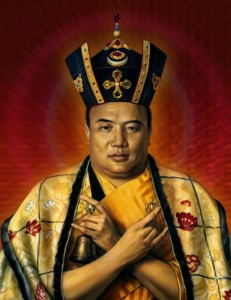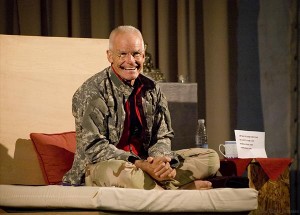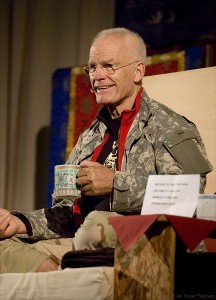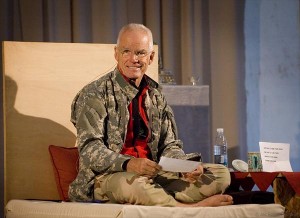This interview was conducted by Stefan Watzlawek and Melanie Zaremba on May 24, 2006, in Houston, Texas and appeared in Volume 20 of the Magazine Buddhism Today published in 2007 and is also held on the Buddhachannel.tv online portal. It concerns the main practice taught in Diamond Way Buddhist Centres worldwide, the “Guru Yoga” Meditation on the 16th Karmapa.
The meditation on the 16th Karmapa is the main meditation in all of our centers, and every new person coming to our centers first meditates on the 16th Karmapa. Why? What is so special about this meditation?
Karmapa wanted that from those who saw him as a buddha. He first started giving this meditation to Hannah and me in 1970, during our first three years in the Himalayas. During the 12 years we were with him, most of the time when we had to leave he put two dark, coarse pieces of very strong Bhutanese paper into our hands. They contained this very meditation, hand-printed in bold Tibetan letters. He often mentioned that this practice would be very good for our friends and that I should pass it on in such a way that it would always be relevant and useful to Westerners. Frequently, he repeated that meditation on the Lama is the fastest way of all. Since 1972, I have done nothing but establish Diamond Way centers for lay people worldwide. That’s why Hannah and I are totally convinced that wherever this meditation is used, things will fit. Where this meditation is practiced, people stick together. Everything stays fresh, and one can feel the confidence and a stream of blessing that helps people mature quickly. There are several Tibetan-style monasteries and groups in the West. There, people mainly meditate on buddha forms of energy and light, and sing invocations in Tibetan language. Such practices employ the finest of spiritual science regarding the feedback of enlightened forms, colors, and vibrations on body, speech, and mind. But experience shows that everything there falls apart easier. People have more discussions and there is less of a down-home feeling that holds them together. Through the great gift of his joyful powerfield, the 16th Karmapa consciously filled space with his enlightened mind-stream. Simply because he was so great and possessed limitless bliss at all times and places, this method is very effective. Taking a closer look at its structure, however, one understands that this practice is more an instant initiation into the Lama than a meditation on him. Therefore, it is something very close.
How and when did the meditation on the 16th Karmapa appear?
It was given after the 16th Karmapa’s escape from the Chinese in 1959. At that time, a lama from Bir in the Western Himalayas asked the 16th Karmapa several times to pass on something meaningful, powerful, and short for the new world. It worked! No Tibetan meditation is used as much in the West as this one.
Is it possible to reach enlightenment just by doing this very meditation?
To quote the Great Yogi Chen, a highly accomplished teacher of Hannah and myself who did not leave his home in Kalimpong for 21 years, “When male and female essences are balanced in a lama, any meditation on him is Maha- Annuatara-Yoga-Tantra, the fourth and highest initiation level.” In this case, any practice identifying with the teacher may bring the highest level of accomplishment. Since not all Karmapas were monks, bliss and space are inseparable in his transmission. Called “de-tong” in Tibetan, it is the heart of our Diamond Way and my own daily practice. After having taken refuge in the morning, such identifications are the best for building up energy and moments of insight during the day.
Why is it, then, that we still need practices like the Ngondro, for example?
 They make you tough! Also, when practiced in the right way, the Ngondro may take one to the goal. The practice is, however, designed to be used as a “preliminary.” With this basis, one can better melt together with the Lama and accomplish his qualities. Guru Yoga, however, is the most important practice for us.
They make you tough! Also, when practiced in the right way, the Ngondro may take one to the goal. The practice is, however, designed to be used as a “preliminary.” With this basis, one can better melt together with the Lama and accomplish his qualities. Guru Yoga, however, is the most important practice for us.
This became known already since Marpa visited Naropa in India the second time, around 950 years ago. At that time, a huge and bright form of the Buddha Kye Dorje (Skt. Hevajra now Oh Diamond) with his partner No-Ego Nairatmya (Skt. Dagmema), condensed next to Naropa and was as large as a house. It was Marpa’s most involved buddha aspect. At the moment when Marpa felt this lightenergy form to be more important than the Lama, Naropa laughed. He transformed the entire manifestation into rainbow light and drew it into his heart. Then he said, “With us, everything is the Lama.” That’s how it is. Whoever is capable of seeing a human form as perfect is much closer to experiencing the world as a pure land than somebody who practices with the far easier light-energy forms. Things close to home—daily and lasting practices— those are what count.
Where do you see the main difference between this practice and other Guru Yogas, for example on the 8th Karmapa?
In its application. The blessing of the lineage and one´s recognition of mind’s nature are the same everywhere, but this practice is especially easy, practical, fast, and efficient. Above all, Hannah and I were given and carry the energy of the 16th Karmapa. At the same time, however, he gave us the meditation on his 8th incarnation to be continued after the Ngondro. The 8th Karmapa was given as the general yidam, both for us and our students as well, because this meditation pushes such a wide variety of unusual buttons in our subconscious. All invocations of the lama are good and show us mind directly, but they take us there through different means. The 2nd Karmapa, for example, invokes a huge protective powerfield, the 3rd opens us up through wishes and insight, and the 15th brings ultimate meditations on union. But for today’s chopped-up lifestyle and goal-oriented thinking, the 16th Karmapa meditation is right for us. He is so close, his power is so massive, and his broad and liberating joy vibrates in our Diamond Way centers everywhere. Because he blows away all tight and bureaucratic tendencies, he is the boss.
When we are done with Ngondro and practice the 8th Karmapa meditation, does it make sense to practice the meditation on the 16th Karmapa as well?
One cannot always manage to eat a full meal. Sometimes a hot dog fits. It is the same with meditations. Even when one enjoys the 8th Karmapa for one’s own main meal, for the time in between the 16th is excellent.
How often should we do the meditation on the 16th Karmapa?
There are no rules, just suggestions. At least so often that one feels surrounded by blessing and that a good wind pushes one forward. If one experiences everything as at least interesting and life as fresh and meaningful, the meditation works. This practice of identifying with the lama is a steady injection of vitamins in one´s life.
Should we do it on a daily basis along with Ngondro practice?
It is not possible to always practice the Ngondro. Certain conditions—inner as well as outer—are needed, as is time. However, meditating on the 16th Karmapa as inseparable from one’s own lama is immediate and easy. If people are moody or tired during the day and then take in the lights, the strength of the veils dissolves. Also, one doesn’t have to take refuge each time. Whoever takes refuge in the morning and keeps a feeling of wishing sentient beings all the best may let the lama appear at any time and can use the lights and mantras whenever one likes.
Sometimes you say that we can practice this meditation at work during a break. Can you explain how to do this? Are we taking refuge? Do we practice the dissolving phase?
The phase of dissolving the lama into light, merging with that, and then becoming the timeless space of awareness, I would do each time, even if only possible for moments. It is exceedingly important. If one can meditate for a longer time, it is useful to go through all the steps contained in a given text.
Is it possible to do anything wrong when meditating on the 16th Karmapa?
Here and now, I couldn’t think of anything to warn against. Meditation is such a round thing, and by following the text one slides automatically from one level of blessing to the next. I would say that whoever is without “roof damage,” as we say in Europe, and knows how to read can hardly do anything wrong.
Are there people who you would advise not to do the 16th Karmapa meditation?
If they simply don’t like its feeling. There are people often of the envious-proud-angry types for whom such a bond to the teacher is too much. They simply don’t like its closeness. Then one advises them to instead do the shine/ lhaktong (Skt. shamatha/vipassana) holding and calming insight meditation, which is something neutral. If people can’t develop confidence in the realization of another human being, or if they don’t enjoy it, there exist other fine but less complete meditation methods than the Guru Yoga. Nothing is more effective than identifying body, speech, and mind with those of a buddha.
What do we visualize while saying the mantra? Are the lights still shining into us at this point?
With some people yes, and that’s okay. The reason for inserting an empty line before the mantra into our recently printed text is that some meditators started reciting the mantra before having taken in the three lights together. This happened also to me, therefore I noticed it, and also Shamar Rinpoche warned against this tendency. The three lights simultaneously bring the limitless transmission of the Great Seal. That’s why we inserted an empty line and in some languages also the word “pause.” Hopefully in this way, after having basked in the blue light, one doesn’t skip taking in the three lights as a unity before the mantra phase.
In the dissolving phase everything disappears. If we keep our eyes open, an outer world is still there. How should we understand this?
This is no problem at all. The disturbance is not the stream of sense experiences, but one’s habitual judgment of things. Only this attachment hinders one’s meditation, and with such realization the tendency must gradually dissolve. One certainly also perceives the movements in one’s body, the quality of one’s seat, one’s breath, and many other kinds of stimulation. These may come and go but shouldn’t distract; they shouldn’t be given any importance when meditating. I often compare this to watching CNN or BBC. One rests with the main picture, that which is happening. Underneath runs the news bar. This strip containing all kinds of information does not disturb and may even be useful. I mention this especially to women, because they are most plagued by thoughts. For their benefit, I hope to have found an unforgettable example and antidote: One meditates as if relaxed after doing a fulfilling job all day. Calmly one hears the children playing in the background and one only jumps into action when noticing that they will put their little sister into the sausage machine!
When the three lights are shining together, we experience the Great Seal and we rest in “Karmapa’s state.” In the dissolving phase of the 16th Karmapa meditation, there is only “awareness, beyond center and limits.” Is there a difference? Aren’t both phases of the Great Seal?
Yes, they are. But the Great Seal consists of foundation, our Buddha nature; way, our non-dual methods; and goal, enlightenment. We here distinguish a “striving” Mahamudra with form and a “realized” state of awareness beyond this. The Great Seal is without any limitations. Its basis is space, the buddha nature of every sentient being, mind’s inborn and limitless awareness. Its path is the awakening of devotion and use of the conscious power contained in body, speech, and mind. And its goal is timeless spaceawareness— fearless, joyful, and compassionate. Experiencer, object experienced, and experience here become one, and whatever happens or doesn’t happen is mind´s free play. Absorbing the lights together thus opens us up for the ultimate state of non-duality.
Please explain each phase of this meditation.
Generally speaking, the beginning and sequence of all Buddhist meditations is the same. One watches one’s breath and remembers the four basic thoughts of precious human body, impermanence, causality, and reasons for reaching perfection—until one understands that these relate to oneself. Before this realization becomes cluttered with ideas, one gratefully takes refuge, develops one’s mind for enlightenment for the good of all beings, and then goes on to the building-up phase. In this meditation it means letting one’s trusted teacher appear as inseparable from the 16th Karmapa and Kagyu lineage—as “Tibetan” as one likes (that is, with the wished-for amount of cultural markers around him). But always there should be the Black Crown. Its very form exposes beings’ unconscious and allows for quick changes in one’s character. This is the building up stage. The empowerments of the lama’s body, speech, and mind then follow. They are transferred through the three lights in sequence, leading to the ultimate empowerment of the Great Seal given with the three lights together. Mind’s capacity is sharpened through the syllables and mantras used. Then one dissolves the lama in front into light, melts this into one’s own experienced body, and, according to one’s ability, lets everything inner and outer dissolve and return into space. Now, only radiant consciousness remains. From this state of awareness the non-separation of space and appearances is recognized, and mind becomes limitless. Before the experiencer again becomes unclear or habits catch up, one lets a pure world appear. Everything around is now fresh and exciting, and mind’s potential simply shows its richness with each inner or outer event. All sentient beings have buddha nature, and even though everything is true on the ultimate level—just because it happens or not—one is free on the relative level to create the circumstances that one likes. Such freedom convinces the meditator of his innate buddha nature and potential, and the sign of the Diamond Way is always and everywhere the same: The practitioner does not leave the pure land again. Instead he strengthens the purity of his experience in everyday activities according to his ability, until one can again reinforce it fully during the next meditation. The openness of the practitioners for this text has changed markedly during the last 35 years. In the beginning, everything “Tibetan” was magic and significant— the gold on the crown and all of the details on it. However, in actuality only the black pentagonal form of the crown denotes the hairs of the 100,000 enlightened female forms (dakinis or khandros, sky-walkers). The ornaments donated by the devoted Chinese Emperor 600 years ago and later blessed by the Karmapas were given great importance, as well as the world’s riches around and underneath his form. Then the three lights became important by themselves. Actually, in its original version, they were only absorbed together and at the same time. It was on Hannah’s and my request that we now do them individually first. Afterward, the meaning of the mantra that became prominent and this movement toward the allimportant ending of the meditation continued until today, where the possibility for enlightened action appearing after the naked awareness of the dissolving phase mainly inspires people. The continuation of the pure view in one’s daily life is a never-ending and deeply inspiring job. Working with people makes sense. They all are essentially buddhas who just haven’t recognized this yet. And, if one observes well, everything happens within a most meaningful framework. I think that returning to the world with the power of the meditation and improving it is what inspires people most right now. But it is also possible that—once the 17th Karmapa Thaye Dorje gets back his crown and it is not damaged, which we hope very much—the beginning stages of the meditation will regain their importance. The 16th Karmapa hardly showed the crown publicly after 1980, and one year later he died.
What does it mean “to rest within the mantra”?
Our languages were not constructed to handle nondualistic concepts, but the meaning is to rest within the sound itself. That is to say in the experience of sound and emptiness, vibration and space being inseparable. After having felt the beyond-personal influences of the vibrations in one’s inner energy-lines and wheels, one gets lost in the vibration. It then has no center or limit, in its essence it is timeless and limitless. Here, especially the Om Mani Peme Hung is well-known. Its six syllables remove the six disturbing emotions of pride, jealousy, attachment, ignorance, greed, and anger, and the 100 syllables of the effective Diamond Mind invocation invoke the same number of purifying buddha families. If several people recite a mantra together, everything starts to vibrate and hum; and people today, who are looking to meditation for quiet “inner” time, then find it here. At the same time, many beyond-personal and most useful buttons are pushed subconsciously.
Do you see us still practicing the 16th Karmapa meditation in the next 50 years, or will we be doing something else?
Absolutely, but probably along with other fast working meditations, such as melting the preferred buddha or lama into oneself from above and staying in that space. I don’t know what the 17th Karmapa may bless us with. I mentioned a few times that there are people who would like a meditation from him. He looked a bit startled, as if this was not necessary and asked me, “Does it have to be now?” As he understood that it was nothing urgent, he seemed relaxed. All Karmapas are the same stream of consciousness, and different incarnations choose to work in different ways.
Is there anything else you would like to say regarding this topic?
I would like to again point out the great and precious opportunity we have through our guru yogas. We are exceedingly rich to have such direct connections to our buddha nature through the blessing of an unbroken transmission. And I would like to assure those who might know the Karmapa only slightly that although “Karmapa” is the title for the first reincarnation-line in Tibet, the power stream of the lineage includes whoever shares in his work and brings the blessing of the buddhas into the world. Also those who have never met any Karmapa or are confused by some exotic aspects of Tibetan culture are fully included through their wish to be of benefit.
Do you have any brief advice for a Diamond Way practitioner’s daily life?
First of all, maintain the pure view. Try to see everybody and everything on the highest possible level. Meditate when possible, even if only for a few minutes. Use mantras when not engaged in learning or other necessary mental activity, and consciously enjoy their blessing and protective aspects. Understand everything pleasant as a blessing and something good to be shared with others, and see everything unpleasant as a life-experience, as purification and a teaching that should help others later. Don’t judge your meditations, and enjoy the aware space behind and between the experiences. It is your buddha essence and the source of highest, timeless bliss. During repetitions of prostrations and mantras, some mental distraction is permissible. However, it should be avoided during the phase of dissolving with the buddha or lama, or when meditating on mind directly. Also: memories, thoughts, and feelings may appear but should not catch one’s mind. In this case, let the thief enter an empty house. Please stay conscious and don’t let him find anything! All the best for you all and enjoy our rich qualities.
Buddhism Today, #20, 2007
Buddhism Today aims to be a living document of authentic Buddhist transmission for the lay person and yogi practitioner in the West. Online subscription to the magazine is available at the website: www.buddhism-today.org. he photographs were taken in 2007 by Jes Roger Petersen and are used with his kind permission.
Other posts which may be of interest :
Tags: 16th Karmapa, 16th Karmapa meditation, advice, Buddhism, Buddhism Today Magazine, Foundatational Practices, Lama Ole Nydahl, Meditation, practice








 Follow
Follow
Thanx for that! Very usefull
Cheers brov! Excellent article.
An excellent article, thank you for sharing it
alguien podria decirme donde puedo encontrar esta estrevista en español, por favorrrrrrrrrrrrrrrrrrr
Saludos oaxaqueños
Maybe in one of these?
http://budismohoy.org/numeros-anteriores.html